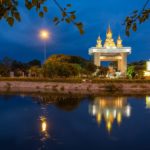
What Did King Chulalongkorn Do? His Achievements

Seen Above: A photo of King Chulalongkorn (center) while in Europe in 1907.
Every year Thailand celebrates a holiday called “Chulalongkorn Day” on October 23rd. This leads some people to ask, “What did King Chulalongkorn do?” Let’s answer that question in detail now.
King Chulalongkorn of Siam is also known as Rama V. His 42 year reign lasted from 1868 – 1910. He is a monumental figure of history. His achievements and accomplishments are vast, as he was instrumental in bringing Siam (Thailand) from a feudal state into the modern age. Without his stewardship it is unlikely that Thailand would have been able to navigate the challenges of the 19th and early 20th centuries as well as it did.
King Chulalongkorn’s Key Achievements include:
Abolition of Slavery: He abolished slavery in Siam in 1905, becoming one of the first countries in Asia to do so.
Administrative Reforms: He undertook major administrative reforms, centralizing power and modernizing the government structure. He introduced ministries, a modern legal system, and restructured the military.
Modernization of Education: He promoted education by establishing the first schools, inviting foreign experts to teach, and sending Siamese students abroad to study in Europe. This helped lay the groundwork for modern education in Thailand.
Financial Reforms: He implemented fiscal reforms that stabilized the economy and improved tax collection, leading to increased revenue for the state.
Legal Reforms: He codified laws and established a legal framework, promoting fairness and justice within the legal system.
Modernizing Institutions: He modernized the Siamese military, creating a standing army and navy, and implemented changes to the social hierarchy, reducing the power of traditional nobility.
Diplomacy and Sovereignty: King Chulalongkorn skillfully navigated international diplomacy, successfully preventing colonization by European powers. Siam remained the only Southeast Asian country not colonized during the European scramble for Asia.
Cultural Preservation: While modernizing the country, he also sought to preserve Thai culture and traditions, encouraging the study of history, arts, and literature.
Public Welfare: He initiated public welfare programs, including healthcare improvements and disaster relief efforts, demonstrating his concern for the well-being of his subjects.

How Did King Chulalongkorn Help Northeast Thailand (Isan)?
King Chulalongkorn’s achievements benefited the entire Kingdom of Siam, including the Northeast of Thailand, known as Isan. Some of the achievements and successes that directly improved the lives of the Isan people include:
Infrastructure Development: The king initiated infrastructure projects in the northeast, such as building roads, bridges, and irrigation systems. These developments contributed to better connectivity, enhanced agricultural productivity, and improved living conditions.
Agricultural Support: He introduced agricultural policies to support farmers in the Isan region. He promoted the cultivation of cash crops, such as sugarcane, cotton, and silk, to diversify the local economy and provide new sources of income for the Isan people.
Land Reforms: Recognizing the importance of land ownership for rural communities, His Majesty implemented land reforms to grant land titles to Isan farmers, helping them gain more secure land tenure.
Water Management: The Isan region faced challenges related to water scarcity and flooding. King Chulalongkorn’s administration worked on water management projects to control floods and improve water availability for agricultural purposes.
Educational Initiatives: The king promoted education throughout the country, including in the Isan region. He established schools and encouraged the training of local teachers, providing educational opportunities for the people.
Healthcare Improvements: King Chulalongkorn’s efforts to modernize healthcare included initiatives in the northeast. He established hospitals and medical facilities, contributing to improved healthcare services for the people.
Local Administration Reforms: The king’s administrative reforms extended to the Isan region, leading to more efficient and responsive local governance.
Isaan Cultural Preservation: His Majesty also recognized the cultural diversity of the Isan region and worked to preserve local traditions and heritage.
So, when someone asks you about King Chulalongkorn’s achievements, and why Thailand celebrates “Chulalongkorn Day” on October 23rd every year, you now have the answer. This Thailand national holiday commemorates his enormous contributions to modernization and reforms that benefited of the Siamese people.
- The Hidden Dharma of Thai Language & Culture - May 11, 2024
- The Royal Ploughing Ceremony in Thailand – A History - May 8, 2024
- Dying Well the Buddhist Way in Thailand - May 7, 2024




